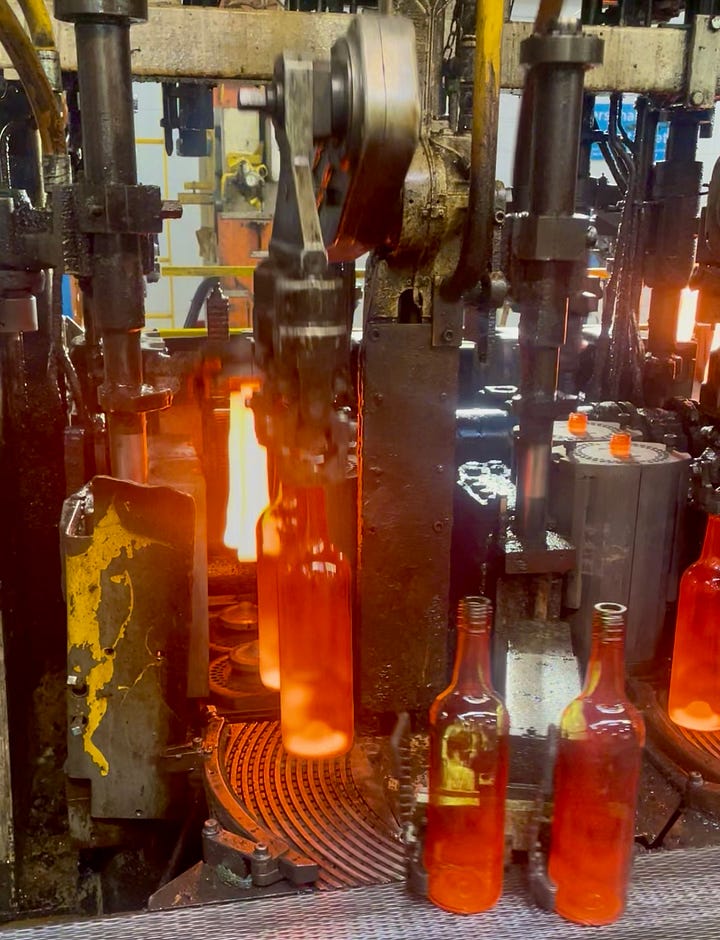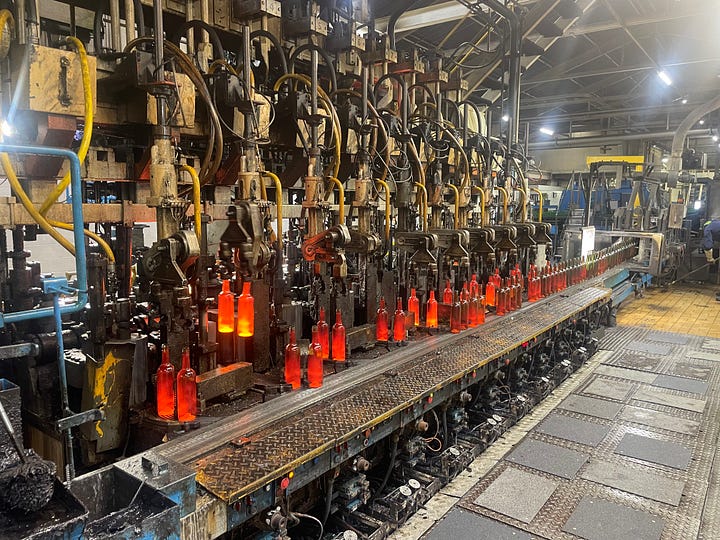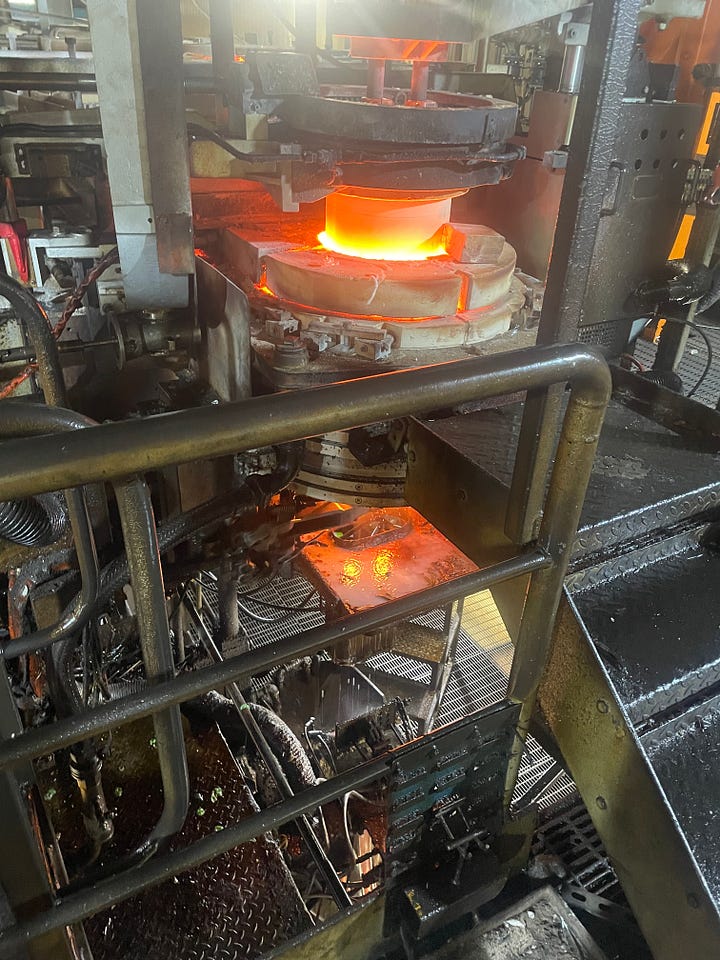Message in a bottle
Glass is the biggest part of wine's carbon footprint - and a challenge for those going green. I went to a huge factory to investigate. Plus: my top bargains from Majestic




The noise standing next to the bottle moulding line is deafening (though I am wearing ear protectors.) On screens in a room somewhere above the line, video flickers of the interior of the furnace, a chamber filled over a metre deep in molten glass. Bright orange “gobs” of glass are cut from a stream emerging from the furnace, then shoot down to the moulding machines below. Then a row of ten robotic arms lift the red-hot wine bottles – they are still at around 550℃ – from the moulds two at a time, every eight seconds, and put them on a conveyor belt down the production line. This furnace can turn out 345,000 bottles a day.
Ardagh Glass Packaging’s sprawling factory in Barnsley, South Yorkshire seemed as far as it was possible to travel from the sunny spring afternoon in a Greek vineyard where I’d been less than ten days before. But it is just as vital a part of making a wine more sustainable as is avoiding chemical pesticides or putting solar panels on your winery’s roof.
Around 85 per cent of wine is sold in glass bottles. And their manufacture alone accounts for at least 20 per cent of the average bottle of wine’s carbon footprint – as against about 15 per cent for growing the grapes and making the wine. If you take into account the weight of glass to transport, it is responsible for 30 per cent or more of the total carbon footprint (one study put it at 42 per cent and it can be up to 50 per cent.)
Glass’s climate-change problem stems from the fact that making it is extremely energy intensive. Whether the glass is being made from virgin materials – sand, limestone and soda ash – or recycled “cullet” – crunched-up granules of glass – those need to be heated in a furnace to between 1,500 and 2,000 ℃ to melt into liquid (cullet melts at a couple of hundred degrees lower than sand.) And since the late-nineteenth century, the normal furnace fuel has been gas, which generates a lot of CO₂ emissions.
Not only that, but you can’t switch a glass furnace off: it takes too long to get up to heat, and you can’t let the molten glass in the system cool and set. So once on, you are running the furnace continuously – albeit not always at full power – over its 15-plus year lifetime. For these reasons, 80 per cent of the carbon emissions in glass manufacture are associated with the furnace.
Yet despite challenges from cans and bag-in-box, glass remains the container of choice for wine. A bottle will always carry more prestige than a can or box. And while aluminium protects against oxygen, only a bottle will store wine basically for as long as the wine is drinkable. It’s no more than 18 months for the alternatives. Bottles are convenient, even if heavy.
What’s more, glass is highly recyclable – which bag-in-box liners are not – though it does need a small proportion of virgin materials added to the recycled cullet to maintain quality. Green bottles can be up to 93 per cent recycled glass, with a little sand added for the balance; for the clear or “flint” bottles used for rosé and some whites, the recycled content is only 30-40 per cent, as more than that introduces visual impurities into the finished product. Recycled glass also has lower emissions than glass made from virgin materials, because melting soda ash and limestone causes carbon emissions in addition to those from the fossil fuel used to fire the furnace.
The wine industry’s first easy win in reducing emissions should be to cut the weight of wine bottles. Some bottles can weigh up to 1.2kg – not including the wine in them. It’s an entirely unnecessary and wasteful marketing choice, unfortunately associated by importers and consumers in some markets with higher-quality wine. Valentina Lira, Sustainability Director at giant Chilean producer Concha y Toro, says that their average still-wine bottle weighs 450 grammes, and they have committed to lowering that to 420g by the end of next year. But she told me: “In the Americas, people are very attached to the idea that a heavy bottle means a good wine.”
They shouldn’t be. “One kilogramme bottles? “We could get three out of one of those!” jokes the manager showing me around Ardagh. It’s true: I watched 400g and 300g wine bottles coming off their production line. In fact, Ardagh has a more radical research and development project that is trying to developing coatings that would allow the glass to be even thinner yet keep the same strength. But those seem to be some way off commercial production.
There aren’t yet many wine bottles on supermarket shelves where the glass weighs in at under 400g. The Sustainable Wine Roundtable’s Bottle Weight Accord has set the goal of reducing the average weight of 75cl still wine bottles to below 420g by the end of 2026. The biggest issue in getting producer acceptance of 300g bottles, say Ardagh, is shock resistance on bottling lines, where bottles bump into each other and there is some potential for metal-on-glass contact with machinery. Ardagh are working with manufacturers of lines such as Germany’s Krones and big bottlers such as Greencroft, near Durham, UK, using equipment such as shock loggers and high-speed cameras to understand exactly the pressures bottles are subjected to.
It's trickier with bottle-fermented sparkling wines such as champagne, which need more robust bottles to withstand internal pressure of up to 5-6 bars (two to three times the pressure in a car tyre) in the finished wine. There has been some reduction in some champagne bottles’ weight, and the authorities are working with wine producers and glass manufacturers to get the weight down to 800g. That’s still a lot. Meanwhile, if all still wine producers switched to 400g bottles, it would make a huge difference the wine industry’s carbon footprint.
The more radical solution to making glass more sustainable is to cut its manufacturing emissions. This is technically challenging. Ardagh run more efficient furnaces in various places such as Doncaster, South Yorkshire, that can save up to 14 per cent in emissions. Big international glass group Verallia introduced the first all-electric glass furnace in 2023 at its plant near Cognac, France. It says that this reduces carbon emissions in glass manufacture by 60 per cent.
In the same year, Ardagh unveiled its NextGen furnace at Obernkirchen, Germany, which will ultimately operate on a mixture of 80 electricity and 20 per cent natural gas. Ardagh says this will lead to a 69 per cent drop in emissions. The next step will be to replace the remaining gas with hydrogen. Ardagh have one Hydrogen Electrolyser plant in Sweden which replaces up to 20 percent of the natural gas used with “green” hydrogen made on site from renewable energy. They intend to combine this technology with and electric furnace in the future.
It's all very expensive: investment in retooling the Verallia Cognac plant cost €57 million, while Obernkirchen took Ardagh six months to build and costs more both to build and run than a conventional gas furnace. Electric furnaces are expected to have shorter lives than gas ones (around ten years rather than 15 – though they’re too new for any to have to been decommissioned yet.) The plants also demand a consistency of renewable grid power supply that is not yet available in many countries.
Once again, such manufacturing challenges seem a long way from vineyard discussions I’ve had recently with Greek and Chilean biodynamic winemakers: the role of hydrogen in glassmaking versus the role of manure in the fields. Except they’re not: the challenge of sustainability ties it all altogether – and wine producers who are wide awake know this. You can’t call yourself sustainable for using renewable energy and recycling winery water if you’re still using heavy bottles.
Some bigger producers have sustainability departments to take care of this and they’re doing a good job: for example in South Africa, both Boschendal and Spier, in Stellenbosch, have bottle lightweighting targets built into their sustainability strategies. But Iona and Radford Dale, in nearby Elgin, small but fleet-footed organic or biodynamic producers without sustainability directors, are both already using lighter bottles than the big boys. Another smaller South African producer told me he cut his carbon footprint by 22 per cent after taking heed of British wine guru Jancis Robinson, whose team highlight unnecessarily heavy bottles in their published notes.
There are times when these kind of sustainability challenges seem dizzying: everything is connected to everything else, with the ordinary products we use every day – like wine bottles – enmeshed in highly complex global supply chains. But I take heart from seeing people in the wine trade come up with smart solutions that make a difference, from the vineyard to the factory floor. And the bottle you pour your glass from tonight is a key place to start.
Value wines from Majestic
It seems more readers have viewed and liked my recent post about value buys from the Wine Society than any other blog I’ve written. While I don’t intend to return to full-scale reviewing of supermarket bargains (I did that for nearly a decade as the London Evening Standard’s wine critic and got pretty bored), it looks like there is an appetite for more such recommendations.
Majestic is now the UK’s only remaining high street specialist wine retailer: I wrote six months ago about its changing fortunes, and resurgence over the past five years after disentangling itself from ludicrous competitor Naked. So it seemed a good idea to go to its spring press tasting last week – plus, my very smart and experienced book co-author, Jane Masters MW, is a buyer there.
In the event, I wasn’t much impressed (sorry, Jane). The effects on prices of both inflation and the Government’s embrace of red-tape-draped duty changes dreamt up by the Tories are becoming painfully clear. Fortunately there were a few bargains worth picking up: the following are the ones at or below £10 when buying a mixed six bottles.
LFE Signature Series Viognier Reserva 2024, Rapel, £9 single bottle, £8 in a six – no wine under a tenner from a big Chilean producer like Luis Felipe Edwards (ca 30 million bottles a year) is going to be that complex, but this is fresh and bright with some classic Viognier notes of peach and apricot. Not at all bad.
Von de Land Riesling 2024, Niederösterreich, £11 single bottle, £10 in a six – I thought this Austrian was the white bargain of the tasting. Fresh, pure and light with zingy acidity, this is very slightly off-dry but would still work well with food.
Famille Perrin “Le Triangle d’Or” rosé 2024, Luberon, £11 single bottle, £9 in a six – Famille Perrin bestride the southern Rhône, from their famed Châteauneuf-du-Pape cuvées to their ubiquitous La Vieille Ferme “chicken rosé”. Competitors must tear their hair out at how the Perrins manage this kind of consistent quality at the price. This rosé is essentially a step up from its chicken sibling: pale, fragrant, fresh – quality quaffing.
Winzer Krems Orange Grüner Veltliner 2023, Austria, £11.50 single bottle, £10 in a six – this wine from the Winzer Krems co-op is an unusual take on Austria’s national grape, Grüner Veltliner, in that it’s orange – were a white wine is macerated on the grape skins (“skin contact”) before fermentation, thereby picking up a deeper colour. Despite a Tango-coloured label, it’s not actually very orange in colour, more a pale orangey-golden. And while there are trademark orange-wine marmaladey notes, it’s fresh and clean. Worth a try.
Pringle Bay Pinot Noir 2022, Western Cape, £9.50 single bottle, £9 in a six – South Africa offers some of the keenest wine bargains at present: it’s hard to think of where else you’d find a Pinot this convincing for under £10. Fresh, pure and quite light but balanced, reflecting the use of some fruit from the cool-climate zones of Elgin and Hemel-en-Aarde. NB the producer is certified by WIETA, the South African body that audits wine workers’ working conditions, housing and labour rights.
Altaland by Catena Cabernet Sauvignon 2022, Salta, £13 single bottle, £10 in a six – Altaland is a project in several less-well-known Argentine regions from blue-chip Mendoza producer Catena Zapata: this wine is from the country’s northernmost wine region, Salta. Dark, ripe fruit balanced with freshness and a touch of oak. Good value in a six.





Imagine what life is like for the only two glass bottle manufactures in South Africa facing regular daily shut downs of electricity.
I really like Jean- Claude Mas wines but some of them are in ridiculously heavy bottles with a glass coat of arms embossed on the front.
Majestic seem to be offering much less discount on mix six - only a £1 a bottle seems common.
Pringle Bay PN very good as Duncan Savage has been involved, but until recently this wine was about £7.50- now much dearer.
Lastly Majestic needs to move to mix three instead of six .
Lighter bottles and Majestic needs to get its act together.
I'm glad you like that Winzer Krems as well - I think it's such a good value, accessible orange wine (it's sold at our biggest wine chain here in the Netherlands as well).